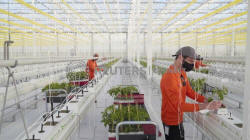Investors seed indoor farms as pandemic disrupts food supplies
 Send a link to a friend
Send a link to a friend
 [February 18, 2021] By
Rod Nickel [February 18, 2021] By
Rod Nickel
(Reuters) - Investors used to brush off
Amin Jadavji's pitch to buy Elevate Farmsí vertical growing technology
and produce stacks of leafy greens indoors with artificial light.
"They would say, 'This is great, but it sounds like a science
experiment,'" said Jadavji, CEO of Toronto-based Elevate.
Now, indoor farms are positioning themselves as one of the solutions to
pandemic-induced disruptions to the harvesting, shipping, and sale of
food.
"It's helped us change the narrative," said Jadavji, whose company runs
a vertical farm in Ontario, and is building others in New York and New
Zealand.
Proponents, including the U.S. Department of Agriculture (USDA), say
urban farming increases food security at a time of rising inflation and
limited global supplies. North American produce output is concentrated
in Mexico and the U.S. Southwest, including California, which is prone
to wildfires and other severe weather.
Climate-change concerns are also accelerating investments, including by
agribusiness giant Bayer AG, into multi-storey vertical farms or
greenhouses the size of 50 football fields.

They are enabling small North American companies like BrightFarms,
AppHarvest and Elevate to bolster indoor production and compete with
established players AeroFarms and Plenty, backed by Amazon.com Inc
founder Jeff Bezos.
But critics question the environmental cost of indoor farms' high power
requirements.
Vertical farms grow leafy greens indoors in stacked layers or on walls
of foliage inside of warehouses or shipping containers. They rely on
artificial light, temperature control and growing systems with minimal
soil that involve water or mist, instead of the vast tracts of land in
traditional agriculture.
Greenhouses can harness the sun's rays and have lower power
requirements. Well-established in Asia and Europe, greenhouses are
expanding in North America, using greater automation.
Investments in global indoor farms totaled $394 million in 2020,
AgFunder research head Louisa Burwood-Taylor said.
The average investment last year doubled in size, as large players
including BrightFarms and Plenty raised fresh capital, she said.
A big funding acceleration lies ahead, after pandemic food disruptions -
such as infections among migrant workers that harvest North American
produce - raised concerns about supply disruptions, said Joe Crotty,
director of corporate finance at investment bank KPMG, which advises
vertical farms.
"The real ramp-up is the next three to five years," Crotty said.
Vegetables grown in vertical farms or greenhouses are still just a
fraction of overall production. U.S. sales of food crops grown under
cover, including tomatoes, cucumbers and lettuce, amounted to 790
million pounds in 2019, up 50% from 2014, according to the USDA.
California's outdoor head lettuce production alone was nearly four times
larger, at 2.9 billion pounds.
USDA is seeking members for a new urban agriculture advisory committee
to encourage indoor and other emerging farm practices.
PLANT BREEDING MOVES INDOORS
Bayer, one of the world's biggest seed developers, aims to provide the
plant technology to expand vertical agriculture. In August, it teamed
with Singapore sovereign fund Temasek to create Unfold, a
California-based company, with $30 million in seed money.
Unfold says it is the first company focused on designing seeds for
indoor lettuce, tomatoes, peppers, spinach and cucumbers, using Bayer
germplasm, a plant's genetic material, said Chief Executive John
Purcell.
[to top of second column] |

AppHarvest crop care specialists complete the first planting of
beefsteak tomatoes at its flagship farm in Morehead, Kentucky in an
undated photograph. AppHarvest/Handout via REUTERS

Their advances may include, for example, more compact plants and an increased
breeding focus on quality, Purcell said.
Unfold hopes to make its first sales by early 2022, targeting existing farms,
and start-ups in Singapore and the United Kingdom.
Greenhouses are also expanding, touting higher yields than open-field farming.
AppHarvest, which grows tomatoes in a 60-acre greenhouse in Morehead, Kentucky,
broke ground on two more in the state last year. The company aims to operate 12
facilities by 2025.
Its greenhouses are positioned to reach 70% of the U.S. population within a
day's drive, giving them a transportation edge over the southwest produce
industry, said Chief Executive Jonathan Webb.
"We're looking to rip the produce industry out of California and Mexico and
bring it over here," Webb said.
Projected global population growth will require a large increase in food
production, a tough proposition outdoors given frequent disasters and severe
weather, he said.
New York-based BrightFarms, which runs four greenhouses, positions them near
major U.S. cities, said Chief Executive Steve Platt. The company, whose
customers include grocers Kroger and Walmart, plans to open its two largest
farms this year, in North Carolina and Massachusetts.
Platt expects that within a decade, half of all leafy greens in the United
States will come from indoor farms, up from less than 10% currently.
"It's a whole wave moving in this direction because the system we have today
isnít set up to feed people across the country," he said.
'CRAZY, CRAZY THINGS'
But Stan Cox, research scholar for non-profit The Land Institute, is skeptical
of vertical farms. They depend on grocery store premiums to offset higher
electricity costs for lighting and temperature control, he said.
"The whole reason we have agriculture is to harvest sunlight thatís hitting the
earth every day," he said. "We can get it for free."
Bruce Bugbee, a professor of environmental plant physiology at Utah State
University, has studied space farming for NASA. But he finds power-intensive
vertical farming on Earth far-fetched.
"Venture capital goes into all kinds of crazy, crazy things and this is another
thing on the list."
Bugbee estimates that vertical farms use 10 times the energy to produce food as
outdoor farms, even factoring in the fuel to truck conventional produce across
country from California.
AeroFarms, operator of one of the world's largest vertical farms, a former New
Jersey steel mill, says comparing energy use with outdoor agriculture is not
straightforward. Produce that ships long distances has a higher spoilage rate
and many outdoor produce farms use irrigated water and pesticides, said Chief
Executive Officer David Rosenberg.
Vertical farms tout other environmental benefits.
Elevate uses a closed loop system to water plants automatically, collect
moisture plants emit and then re-water them with it. Such a system requires 2%
of the water used on an outdoor romaine lettuce operation, Jadavji said. The
company uses no pesticides.
"I think we're solving a problem," he said.
(Reporting by Rod Nickel in Winnipeg, Manitoba; additional reporting by Karl
Plume in Chicago; Editing by Caroline Stauffer and Lisa Shumaker)
[© 2021 Thomson Reuters. All rights
reserved.] Copyright 2021 Reuters. All rights reserved. This material may not be published,
broadcast, rewritten or redistributed.
Thompson Reuters is solely responsible for this content. |